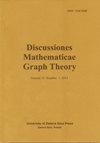General sharp upper bounds on the total coalition number
IF 0.8
4区 数学
Q3 MATHEMATICS
引用次数: 0
Abstract
Let $G(V,E)$ be a finite, simple, isolate-free graph. Two disjoint sets $A,B\subset V$ form a total coalition in $G$, if none of them is a total dominating set, but their union $A\cup B$ is a total dominating set. A vertex partition $\Psi=\{C_1,C_2,\dots,C_k\}$ is a total coalition partition, if none of the partition classes is a total dominating set, meanwhile for every $i\in\{1,2,\dots,k\}$ there exists a distinct $j\in\{1,2,\dots,k\}$ such that $C_i$ and $C_j$ form a total coalition. The maximum cardinality of a total coalition partition of $G$ is the total coalition number of $G$ and denoted by $TC(G)$. We give a general sharp upper bound on the total coalition number as a function of the maximum degree. We further investigate this optimal case and study the total coalition graph. We show that every graph can be realised as a total coalition graph.联盟总人数的一般尖锐上限
设$G(V,E)$是一个有限的、简单的、无隔离的图。两个不相交集$A,B\subet V$在$G$中形成一个全联盟,如果它们都不是全支配集,但它们的并集$A\cup B$是全支配集。顶点分区$\Psi=\{C_1,C_2,\dots,C_k\}$是全联盟分区,如果分区类都不是全支配集,同时对于每一个$i\in\{1,2,\ddots,k\}$,都存在一个不同的$j\in\{1,2,\dots,k\}$,使得$C_i$和$C_j$形成一个全联盟。总联盟划分$G$的最大基数是总联盟数$G$,用$TC(G)$表示。我们给出了作为最大度函数的总联盟数的一般尖锐上界。我们进一步研究了这个最优情况,并研究了总联盟图。我们证明了每个图都可以实现为一个整体联盟图。
本文章由计算机程序翻译,如有差异,请以英文原文为准。
求助全文
约1分钟内获得全文
求助全文
来源期刊

Discussiones Mathematicae Graph Theory
MATHEMATICS-
CiteScore
2.20
自引率
0.00%
发文量
22
审稿时长
53 weeks
期刊介绍:
The Discussiones Mathematicae Graph Theory publishes high-quality refereed original papers. Occasionally, very authoritative expository survey articles and notes of exceptional value can be published. The journal is mainly devoted to the following topics in Graph Theory: colourings, partitions (general colourings), hereditary properties, independence and domination, structures in graphs (sets, paths, cycles, etc.), local properties, products of graphs as well as graph algorithms related to these topics.
 求助内容:
求助内容: 应助结果提醒方式:
应助结果提醒方式:


